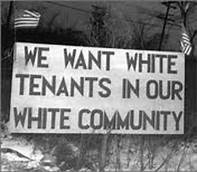Levittown, one of post-World War II America’s most iconic suburban developments, symbolizes opportunity and exclusion. Created by William Levitt and his company, Levitt & Sons, Levittown represented the promise of affordable homeownership for millions of returning veterans and their families. However, this promise came with a deeply troubling condition: the exclusion of African Americans and other racial minorities from these new suburban neighborhoods.
The Levitts developed a total of four major Levittown communities:
1. **Levittown, New York:** The first and most famous Levittown, built on Long Island, began construction in 1947.
2. **Levittown, Pennsylvania:** The second Levittown, built near Philadelphia, began in 1952.
3. **Levittown, New Jersey:** This community, known as “Levittown of New Jersey,” was later renamed Willingboro and started construction in 1958.
4. **Levittown, Puerto Rico:** The final Levittown, built in the 1960s, was constructed in Toa Baja, Puerto Rico.
There developments became symbols of the postwar American dream, where homeownership and suburban living were within reach for millions of Americans—though not for everyone. These segregation policies were enforced not through written covenants but by the developer’s explicit refusal to sell homes to African Americans. This practice was emblematic of the larger issue of housing discrimination that permeated American society during this period.
The roots of this exclusion lie in a broader practice that had already taken hold in the United States well before Levittown’s construction—the use of racially restrictive covenants. These covenants were legal agreements embedded in property deeds or neighborhood contracts that explicitly barred certain racial or ethnic groups from purchasing, leasing, or occupying property. Although such covenants existed before Levittown, with some dating back to the 1910s and 1920s, Levitt’s policies in the late 1940s and 1950s were very much in line with this established practice of racial segregation in housing.
A broader movement in the 1940s and 1950s saw the rapid expansion of suburban communities across the United States, many of which shared similar exclusionary practices to Levittown. In California, Lakewood, often referred to as a “Levittown of the West,” was built near Los Angeles in the late 1940s and early 1950s. Like Levittown, Lakewood was a mass-produced suburban community that used restrictive covenants to exclude racial minorities.
In Illinois, Park Forest was developed in the late 1940s as a planned community for returning veterans. Initially, racially restrictive covenants in Park Forest prevented African Americans from purchasing homes, reflecting the broader trend of racial exclusion in suburban developments during this period. Similarly, Rollingwood, Texas, near Austin, was developed in the 1940s with covenants that prohibited the sale or rental of homes to non-white residents.
Another early suburban development, Shaker Heights, Ohio, enforced restrictive covenants well into the 1940s and 1950s to maintain its status as an exclusive, predominantly white suburb. Over time, Shaker Heights became known for its efforts to integrate and combat housing discrimination, but the legacy of those early covenants lingered.
In Southern California, Palos Verdes Estates, developed in the 1920s and continuing through the 1940s, used restrictive covenants to prevent African Americans, Asians, and other minorities from living in the community. These covenants were part of a broader pattern of exclusion that shaped the demographic landscape of Southern California’s suburban developments.
It was not until the passage of the Fair Housing Act in 1968 that racially restrictive covenants and other forms of housing discrimination were explicitly outlawed across the United States. However, the damage had already been done. Communities like Levittown, designed as exclusive enclaves for white families, had set patterns of residential segregation that would take decades to unravel. The remnants of these covenants can still sometimes be found in old property deeds or records, though they no longer hold any legal power.
The story of Levittown and these other suburban communities is a stark reminder of the ways in which policies and covenants were used to shape American society in the mid-twentieth century. While the legal frameworks that supported such exclusion have long been dismantled, the effects of these practices continue to be felt today in the persistent patterns of residential segregation and racial inequality across the United States.
References:
History.com, Encyclopedia.densho.org, UShistoryscene.com, LongIslandpress.com
